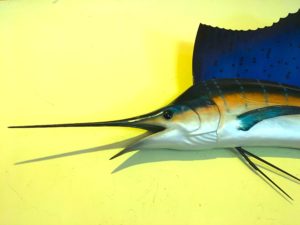 I was living in Miami Beach when I turned 36. For my birthday, my friends pooled their money and gave me a fish. I named the fish Omar.
I was living in Miami Beach when I turned 36. For my birthday, my friends pooled their money and gave me a fish. I named the fish Omar.
Omar is an arcing, six-foot long Atlantic sailfish, a showy and regal sea creature adorned with a dorsal fin that stands like a starched cape along the length of its body. The bill is an elongated sword spackled with what feels like sandpaper. Iridescent silver flecks the blues and greys that color his body. Though Omar has been ferociously fiberglassed, taxidermied and shellacked, that fish continues to radiate a magnificent beauty and a sense of fluid motion. If there were such a thing as a sailfish beauty pageant, Omar would be a real contender. Would have been a real contender.
My brother Andrew found Omar on one of his Saturday morning garage sale forays. After a Cuban breakfast, Andrew meanders through Miami suburbs on the alert for treasures and neglected houses in need of the sort of love only he can provide.
Omar’s owner was named Foy Sperling. He and his wife were empty nesters selling their belongings and motoring on to the next chapter of their lives in an RV. Sperling is a former fishing guide who says that Omar was caught the year I was born by a Japanese businessman in town for a conference and some deep-sea fishing.
When Omar first came into my life I thought of him as a kitschy piece of Floridiana. He was an art piece, an ironic sculpture that dominated a wall in my Miami Beach apartment. He also channeled my grandparents, who lived in a home on the periphery of a golf course. Their Florida room had Omars on the wall and glass shelves that held seashells washed ashore during hurricanes. My uncle Chris went out during storms to collect them. They were as big as cantaloupes and looked as if they were formed with soft-serve ice cream. Fish on the walls of Florida homes was as much a part of my normal as the notion of Santa Claus in red swim trunks water skiing presents to the good boys and girls of Florida at Christmas.
The Miami Beach apartment where Omar and I first lived overlooked Biscayne Bay, a short swim from the wilds of the Atlantic Ocean where Omar had swum and marauded until he was hooked and hauled aboard a boat. Omar is a gamefish, a sportfish, said to be one of the fastest in the ocean. Sportfish are the beasts fishermen seek to conquer and then hoist beside themselves for congratulatory photos. Omar has the heft, allure and speed of another gamefish, the marlin—the muscular adversary Santiago wrestled with in Hemingway’s “The Old Man and The Sea.”
I’m no fisherwoman. And I’m not a hunter. Though Omar hangs on the wall, he is no trophy. Over the years, he has taken on deeper significance. He’s no longer a larky throwback to old Florida decor. He is a talisman telegraphing my childhood and reminding me of the salt water I come from. Swim, he says. Leap. Wear your fancy clothes. Move with pride and purpose.
When I moved to Flagstaff 13 years ago, Omar came with me, nestled on top of the cardboard boxes stacked inside my U-Haul. We are not what we eat. We are what we save and schlep when we move from one place to another. I am 27 boxes of books. I am a dozen grammar school globes. I am a fish who is far from the ocean.
Do we ever overwrite the coding of our childhood? Or do our lives collage? Are they layered like sediment, each era a visible and definable stripe of memory and experience? These are the questions I muse over lately.
I’ve lived in this mountain town for almost 14 years, and I have found home here. This I know. I chanced upon a mid-life tribe, the tonic of this natural world and an unexplainable giddiness when shoveling snow. But I cannot outpace my yearning for water, for the familiarities and comforts of the ocean. So I live with this longing.
And I live with this fish.

